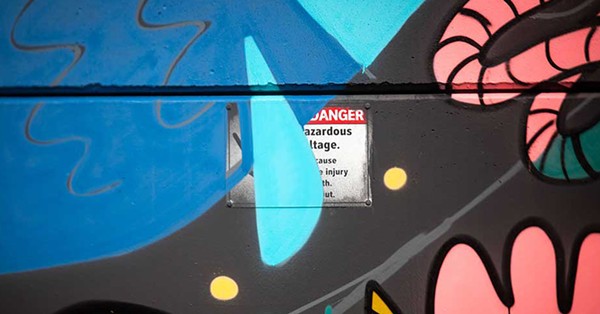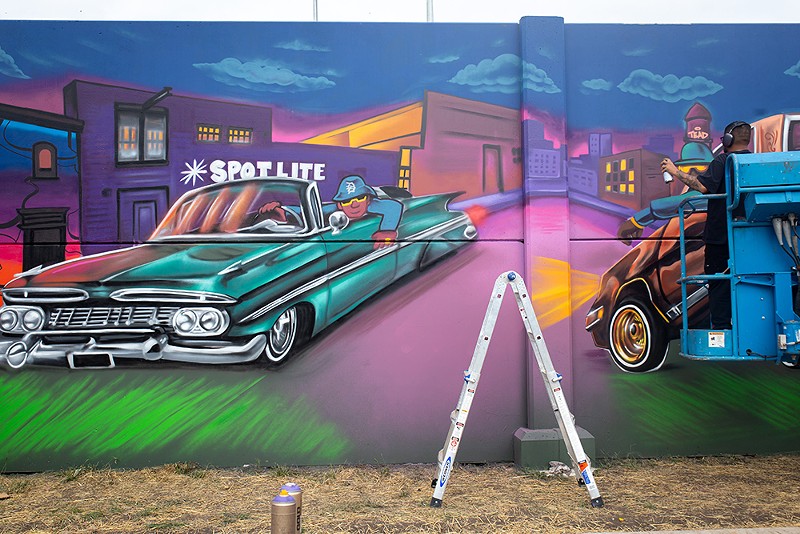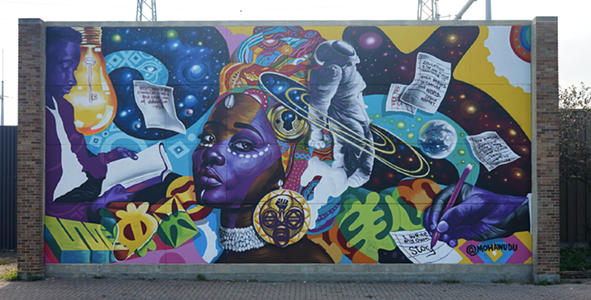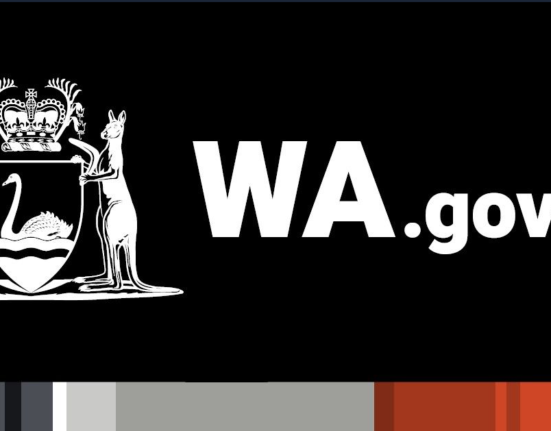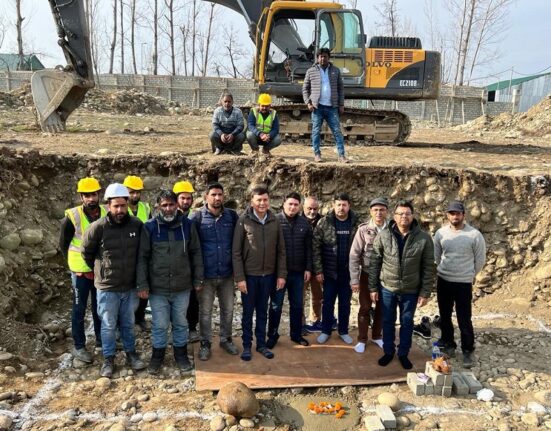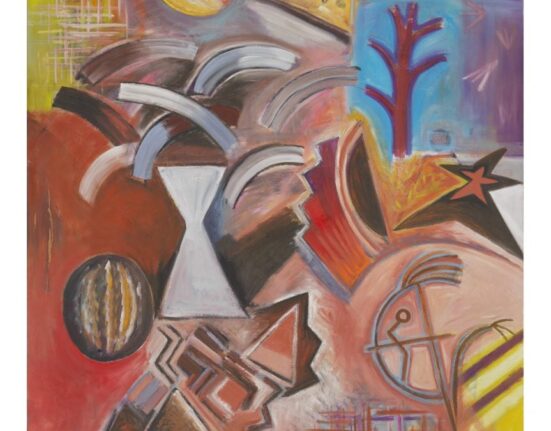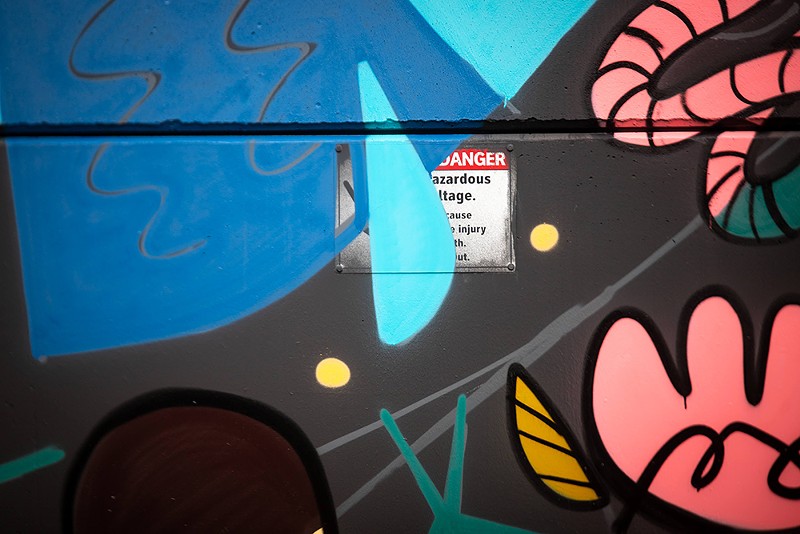
Viola Klocko
Corporations like DTE whitewash their image by sponsoring cultural programming like murals.
Down the street, at the police-sponsored baseball diamond, condos are on sale for $600,000, not far from where the big car company is rehabbing the old train station for its fancy new offices. You can walk a little further and see where the local energy monopoly is paying to whitewash a substation — and their image — with a new mural. When I look at the new painting, I think of the seven days last winter where the company left tens of thousands of people without power, just weeks after paying their shareholders $750 million. It seems like it will take a lot of paint and PR to cover up those memories, but perhaps not.
Around the corner another new mural is being added to a hotel that refused to hire union labor for its construction. It’s a bit hard to see because of all the smoke from the wildfires up north, but this mural seems to show a community of people working and living in harmony through a shared history. I wonder if the people in the mural are worried about their rent.
The city proudly announced that there will be a lot more public art soon. They tell us that the work will be funded by the negligent energy monopoly and the local billionaire’s foundation — in partnership with an art business that helped gentrify the market district. Sometime around 2008, as part of the city’s renaissance, the line between billboard and public art faded. We all have to pull together to ensure that the billionaire can get a return on his generous investment of buying the city. Soon, all the profitable areas will have new murals, depicting happy diverse people who don’t question where their tax dollars go, how much they’re paid, or who owns the land.
In February, the city of Detroit announced plans to add 200 new murals in neighborhoods across the city. The announcement was a high-water mark for the role that murals have played in the city for more than 10 years, expanding with festivals like Murals in the Market and official government programming like City Walls. Increasingly, money has flowed from public, philanthropic, and corporate coffers into these programs, demonstrating a commitment to public mural art as an important slice of the city’s cultural space. Murals have long been touted as a truly public art form, speaking directly to people, bypassing the gallery or museum. One of the most popular and revered artworks in the city is Diego Rivera’s courtyard mural at the Detroit Institute of Art — a painting depicting the working people’s struggle, crafted by a communist and honoring the workers of Detroit.
However, beyond the press releases, something important seems to be happening with this new emphasis in cultural funding. While publicized as an investment in art and beautifying the city, the location, impact, and funding sources of these murals seem to correspond closely with private real estate and corporate investments. This opens up a number of contradictions and questions worth exploring: Why has a mayor who spent years persecuting graffiti artists embraced public murals as a centerpiece of this cultural programming? Why have corporate sponsors lined up behind this new push? What impact does this investment have on the city — both culturally and materially? It all leads to a fundamental question: what role are murals playing today, and how could — or should — our communities approach them?
I want to be clear from the start, that this problem is not primarily the fault of artists, and this is not a call for some purity test around mural work. I have painted murals in the past, and likely I will do so again. Murals present a way to pay bills and support an artistic practice — and they remain a contested site to be fought for. However, the massive investment in murals and their use in racialized capitalist development means that we need to question how our communities should approach this struggle. We need a coherent analysis of what is happening with these corporate mural projects, and we need to step back from the universal celebration these projects have enjoyed. It’s important for us to consider what is happening with public-private sponsored mural projects, identify some criteria for evaluating the impact of a project, and explore how artists and our communities can engage in controlling our cultural production.
First, we must look at the material foundations of what is happening both with the city and the mural push in particular. The city today is experiencing a prolonged period of private investment, targeting and developing key areas of the city for a classic cycle of gentrification to the benefit of real estate and corporate interests. Large funds are being committed to very specific areas of the city — downtown, Midtown, Corktown, Eastern Market, and West Village. These investments are spurred by public funding and tax breaks to the tune of hundreds of millions of dollars, and land deals that allow business interests to buy up real estate for pennies on the dollar. The results of this are predictable: rising property values, rising rents for both long-term residents and small businesses, and displacement and further investment as higher property values mean the land becomes more profitable for another round of investors. Further contributing to displacement is the high costs and low quality of utilities like DTE, who offer some of the least dependable and most expensive electricity in the nation to Detroit residents, while reaping enormous profits. All this is accompanied by targeted, racialized policing, perhaps best exemplified by the city’s Project Green Light program, which essentially pushes small businesses to pay protection money for the police to surveil their property and respond to crimes. The goal is the exploitation and manipulation of real estate values, for the profit of extremely wealthy investors.
As noted above, these plans have been signed off on and directly guided by city officials. The mayor’s office, as well as the majority of city council, have played key roles in pushing public dollars into private hands, through both direct grants and tax subsidies. This is at a scale that dwarfs new public investment in the city, and that actually has taken funds away from critical infrastructure like schools and libraries — all in order to subsidize billionaire developments. While there are innumerable examples, this tendency is best exemplified by the District Detroit, starting with a $1.5 billion subsidy of its anchor Ilitch-owned hockey stadium, supported by city council and accompanied by huge property transfers to the Ilitch family. This was followed by a years of failed promises before the family returned a decade later to ask for another $1.5 billion in order to complete the developments they failed to follow through on the first time. By a vote of 8-1 the Detroit City Council voted to hand more tax dollars and subsidies over to the Ilitches.
This approach has become a norm for the city — and can be seen in its dealings with billionaire Dan Gilbert, just as much as the Ilitches, with projects like his oft-revised and heavily subsidized Hudson site development. City council and the mayor’s office repeatedly choose to conform to the needs, timelines, and budgets of corporations, over those of long-term residents and the neighborhoods.
As we look at the roots of the renewed push for public murals in the city, we find many of the same corporate actors outlined above playing a critical role in starting and guiding these programs. Today the city-sponsored City Walls program partners with private corporations like DTE and foundations like the Gilbert Foundation to fund the creation of murals across the city. The city has also maintained a long-standing relationship with 1xRUN, a company responsible for formalizing and expanding the Murals in the Market Festival in Eastern Market. Across all of these programs, the placement of art projects closely aligns with the real estate and corporate investments of the companies funding them. While murals do occur throughout the city, they are highly concentrated in locations like Eastern Market, Midtown, and Corktown — areas that have simultaneously experienced extreme property speculation.
So we have established that the city is working closely with private capital to create special investment zones through public funding and subsidies, and that these corporations, along with others, are partnering with the city to fund murals in areas that they are investing in, as well as the city more broadly. What does this matter? The wealthy, after all, play a decisive role in almost every branch of our cultural institutions — what makes murals different? Beyond a general distaste for corporate control of our society, what specifically is happening here, and what consequences does it have for our cultural space, and our city?
There are several contradictions that lie at the heart of the city’s push for public mural-based artwork over the past decade. A closer look can help us understand the particular role that corporate murals play in today’s landscape, and try to grasp how we might respond strategically.
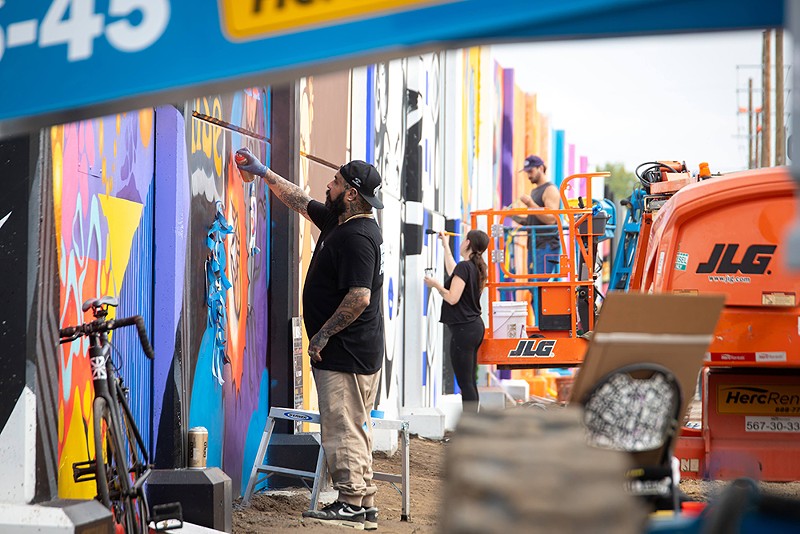
Viola Klocko
The central element of the recent Murals of Islandview festival was the decoration of a DTE substation.
Repression and expansion
On the surface it seems ironic that the Duggan administration, which has spent years persecuting graffiti artists and even the owners of buildings that are tagged, should now be engaged in a public mural campaign. But this is obviously only a false division — the repression of graffiti artists and expansion of officially sanctioned works are part of the same unified policy. This policy seeks to reclaim public space for private capital, and ensure that capital controls the art that is created on the city’s walls. Space needs to be held open for the official murals, and once created, artworks need to be protected to ensure that the “correct” art remains in place. The scale of the new vision dictated the scale of the repression.
This goes beyond just the physical control of artists and space to include stylistic and messaging control. The city program does not accept graffiti-style murals — despite the deep roots of the scene in the city and the deep roots of the style for Black and Latino artists. Hugely impactful graffiti works such as the “Free the Water” piece painted on a water tower in 2014 in response to the horrendous state of infrastructure in the state provoked felony charges from the city. One group of artists, messages, and styles are lifted up, the other is attacked.
Public art controlled by private corporations
The question of what makes one style desirable, and another punishable, brings us to the second contradiction. These ostensibly “public” artworks are in fact selected, directed, and placed by private capital. The city’s public artworks are not crafted by public engagement and collaboration, but via official sanction and guidance of private capital, and in particular several of the city’s largest corporations and wealthy families.
The fundamental goals of a corporation are distinct from those of the public at large. Corporations seek to expand shareholder value, and the mural push offers two routes toward this goal. First, it is a classic opportunity to burnish a corporation’s image. DTE left hundreds of thousands of households without power this past winter just weeks after paying their shareholders millions of dollars. This spring we see a DTE-sponsored art fair and a $75,000 commission to paint a substation. These acts serve to literally whitewash the face of the company, deflecting and dampening criticism. These measures are far cheaper than paying their fair share of taxes or reinvesting in its infrastructure in order to maintain basic standards of living for city residents, and allow the company to continue its exploitation of the community with less overt criticism.
The second way that murals expand value for the rich is by their specific role in the modern process of gentrification, a struggle by the rich to expand the value of land and businesses by manipulating real estate markets and private investment. Murals have taken on a role as part of this process as a tool of propaganda, demarcation, and appreciation. Propandistically they serve to spread a certain image to residents and newcomers about who the neighborhood is for and what values it is built around. As a tool of demarcation, murals serve to help delineate and coordinate where capital investment should be concentrated — creating a feedback loop where corporate murals are used, alongside anchor investments and public plans, to lay out what areas are desirable, indicating to other capitalists where to invest money, and helping to coordinate the individual property investments of second- and third-wave transplants to a neighborhood. Thus, murals become a tool of appreciation, where a certain density of them becomes a way to raise property values, encouraging additional investment. This does not mean that gentrification is started by murals, but it does mean that corporate-backed mural festivals and programs have a strong tendency to develop into work that acts as visual propaganda for the rich — and indeed the struggle for control over messaging indicates that what is painted or created remains of great importance.
This framework helps us understand both the aggressive push against not just graffiti as a practice, but also graffiti-style works, and the dynamics of control of content that develop in these “public” murals. Graffiti artwork is rejected not because of its lack of artistic merit, but because it does not allow the corporate sponsor to expand shareholder value. A neighborhood with tags does not communicate to private investors to add additional investment, and it is not racially or economically coded to the white upper middle class clientele that these areas are meant to serve.
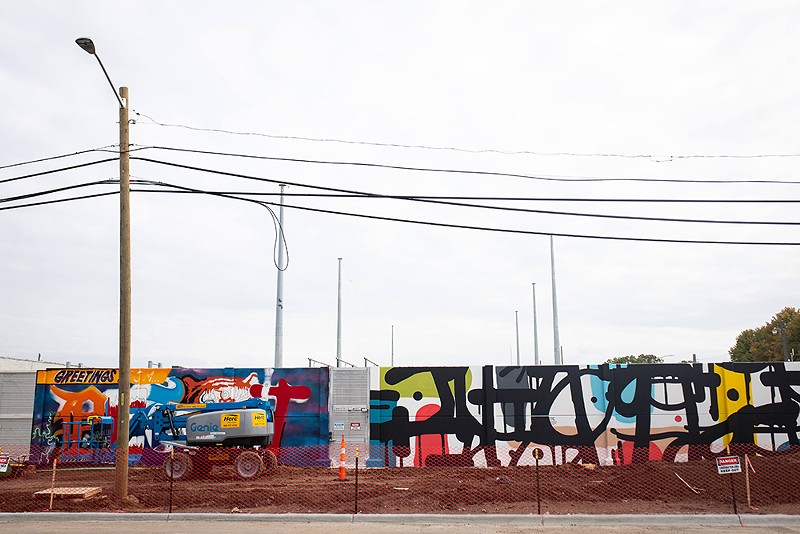
Viola Klocko
Detroit’s mural festivals have created work that has indeed beautified their areas, though little content that speaks to the history or present of struggles in the city.
Furthermore, the content of the murals in general becomes an important site of control. It seems natural that one can hardly expect a large-scale mural critiquing Duggan, Gilbert, DTE, or the Ilitch family to be produced by one of these programs, much less one that questions the extractive nature of capital investment in the city, or the broader trends of displacement, exploitation, and degradation in our society. Nor is this the fault of the artists, who participate primarily as paid hands selling their labor — they are submitting work that they believe will be accepted, just as you would say what someone wants to hear in a job interview. However, the broader effect of so much visual space, artistic funding, and cultural capital being allocated to these projects means that the city and these corporations are exercising a heavy influence on the artistic community in the city. With largely apolitical corporate murals being an on-ramp into an artistic career, the city and corporate sponsors have a key role in deciding what artists and work become valuable in the city. And by extension, these artists will tend to be ones whose messages are more comfortable to corporate sponsors, and whose work more easily aligns with the financial goals of the city and these sponsors. Even subconsciously, artists may begin to tailor their messaging to conform to the needs of these groups — and thereby the norm of cultural production takes (yet another) step toward corporate control. In this way the control of public art by private capital operates as a gravitational well in the cultural and political space of the city. It distorts first the placement, then the content, and finally the career landscape of cultural production in the city — all of which are turned in service of financial goals, not community or cultural ones.
A look through the City Walls and Murals in the Market catalog shows a series of works that have indeed beautified their areas, but precious little content that speaks to the history or present of struggles in the city. And most of this political content operates at the level of racial and ethnic representation, but steers clear of structural critiques, shared histories of struggle, or potential solutions. While representation is an important goal of culture, it hardly seems an adequate endpoint considering the stark divisions in city funding, water and power shut offs, and decades of radical organizing in the city. This omission is itself a critical form of propaganda and suppression: An image of shared success and happiness is constructed in neighborhoods struggling to get reliable utilities and maintain affordable housing. By omitting structural critiques, and monopolizing public spaces, these works contribute to a mythology of shared prosperity and individual failures — where the root causes of problems are obscured, and the solutions are implicitly about individual choices.
No matter how beautiful, a mural can not lower a rent check, and interpersonal kindness can not break Gilbert’s influence over city council. Ultimately the push to create “non-political” art is itself a political choice by these corporations, a strategic part of their control over culture, land, capital, and government. The walls are made beautiful, but seem to say only that everyone is fine, that life is good, and that our future is united. As capital flows into the neighborhood, the work of representation becomes darkly ironic as investors seek to attract disproportionately white upper middle class residents that feed into their development model.
We are left then with a “public” art that is in fact propaganda and a tool of a very specific class interest. While it may beautify space, it does so not on behalf or with the true guidance of residents — or even on behalf of the new more wealthy residents who will take their place — but on behalf of capital, with the goal of speculation, and a return on its investment.
Public art that displaces the public
This then brings us to the final contradiction evolving out of the unity of repression and expansion and of corporate control of ostensibly public art. That is, even as the artwork is brought out of the gallery and into the public space, it contributes to the transformation of who is part of that “public.” Rather than escaping the gallery where the wealthy have long held sway, it has brought the same speculative, exploitative logics of the gallery into the public square.
A strong case study is the Murals in the Market festival, launched in 2015 in Eastern Market by the art gallery and print house 1XRUN in alliance with Eastern Market Corporation, the local development corporation, to create an opportunity for local and national artists to show work on a grand scale. According to the Murals in the Market website, “With the creation of these murals, each area has seen a significant visual impact on the surrounding neighborhood as well as increased traffic, additional economic development, and increased safety.” This includes many euphemisms that become clear the more of these documents that you read, but you can see each of the contradictions that we have analyzed at play in the description. There is the idea that the murals will bring security, without mentioning who provides that security and against who it is exercised; the euphemism of increased foot traffic and additional economic development, both standing in for forces of gentrification; and the implicit assumption in all of this that a corporate-backed mural festival is the best voice to be guiding and curating a festival of public art, in a space where public art already existed.
While Murals in the Market has indeed painted a vast number of murals, and provided a platform for many local artists, it is worth looking at what has happened to the neighborhood since the launch of the project. The most impactful change was the 2019 purchase by real estate investor Sanford Nelson of more than 20 buildings in the Eastern Market district for $30 million. Within the year eight small businesses had closed or relocated, as Nelson increased rents and pushed out long-term tenants. While claiming to want to preserve the character of the neighborhood with an emphasis on culture and dining, this apparently did not extend to preserving the people who lived in the area, the businesses that operated there, or the affordability of any of the real estate involved.
Of course, it would be absurd to blame the Nelson buyout and expulsions on Murals in the Market, as there are a variety of factors that made the area a potential site for re-investment, but it seems clear that the festival’s stated goals and impact — increased security, foot traffic, and economic investment — all would have contributed to making the area more ripe for this sort of destructive transformation.
As a short side note: After 1xRUN sold its Eastern Market storefront for $1.2 million and relocated to the Islandview neighborhood, it announced a new “Murals in Islandview” festival, which launched last month. The central element of this festival was the decoration of a DTE substation in the Islandview neighborhood, an area that has experienced rapid increases in property values over the past few years. Again, we are faced with an area already feeling the pressures of speculation and displacement, being selected for the gift of murals, programming, and culture they have no control over, by an entity they did not invite — ultimately to the benefit of investors.
(After this article was published, 1XRUN contacted us to clarify that it was they who reached out to DTE and convinced it to pay artists to paint its substation walls to beautify the neighborhood; DTE also gave additional funds to benefit the nearby Downtown Boxing Gym. 1XRUN also says the only rules for subject matter for its muralists are no violence, no guns, and no nudity, and says that murals they have produced over the years do in fact have important public messages behind them, including work for the ACLU and to promote voting, among others.)
Within our current system, the process of real estate speculation and development means that these sort of public art projects rely upon corporate support to exist, and that the city itself relies upon this sort of speculative exploitative investment to expand its tax base. The only answer being offered in response to decades of displacement, marginalization, and under-investment is a new round of investment and tax breaks that make rich people richer at the expense of working people.
Large-scale corporate mural projects are not bad because someone decided to make murals, but rather because of the main criteria our system has for financing public art: does it in some way enhance corporate profits or prestige? The desire to create murals is not wrong, the desire to expand public art and build a visual culture is not wrong, and the drive to find support for public art in an under-resourced city is often admirable; but the reality is that these projects are deeply contradictory. Even as they reach out to the public, the act of reaching out helps drive up rents, replace businesses, and exile neighbors. The targeted utilization of public art by corporations and the city means that murals are not and can not be neutral.
Taken together, these contradictions show the distance between the stated goals of the city’s mural project, and the actual impact of this program on our city, our culture, and our neighbors. It shows not the escape from a gallery scene dominated by the wealthy, but the expansion of this domination to fill even more of our public space. The art created draws far closer to billboards for redevelopment than a rooted culture connected to city residents. The community first faces increased policing, then unilateral investment, and finally a rise in the cost of housing. The murals serve less as a mark of beautification than as a sign of corporate control.
Ultimately the public is given a series of murals that tell them that life is good, that problems are about individual struggles, and that their rent is about to go up.

Courtesy of the Detroit Institute of Arts
Diego Rivera’s mural tribute to workers at the Detroit Institute of Arts.
What is to be done?
And so we arrive at the most difficult question of any polemic: what do we do about it? As we have just spent many paragraphs reviewing the structural issues with these programs, we must resist the urge to suddenly lapse into individualism and prescribe a moral solution devoid of context. An individual artist will not make much of a difference by refusing to paint corporate murals, particularly if a main way to have a career involves doing so. In a city so long bereft of arts funding, and particularly funding that offered opportunities to young local artists, a politics of purity and denunciations is both unstrategic and a bit silly. Similarly, begging corporations to not exploit our communities, or to stop supporting their real estate investments, goes against their entire reason for existing. While good people may work for these companies, they ultimately exist not to help our communities, but to produce a profit. No amount of moral suasion will change this.
Our struggle is not with a choice of medium, or Dan Gilbert personally, but with the institutions of capitalism intertwined with racism that condition the way resources move in our city. There is no easy escape from this, there is no life hack, or individual practice that will allow us to be exempt from this system. We should not hate corporate art because it is ugly, we must hate racial capitalism because it means we will never be free.
All this said, there are immediate tasks that I believe begin to confront issues with mural-making, and indeed cultural production more generally. At the foundational level I believe there must be a move to separate city cultural funding from corporate partnerships, and to push decision-making away from development-minded city institutions and toward community residents. Rather than investing in large-scale murals in neighborhoods that didn’t ask for them, the city should be investing in democratic resident-led arts institutions that speak to the culture and needs of these communities. Some communities may prefer different content or artists, others may prefer different mediums; some may use funding to support existing “graffiti” artists with developing their practice, others may invest in public performance or recording spaces. Fundamentally, these institutions must have the ability to say “no” when offered a new proposal or project for their community. Too often consultation is portrayed as power, when the real decisions happened long before the public was invited to give input. What beautification means should emerge from the neighborhoods, not be dictated from downtown or the boardroom. Indeed, there are already respected cultural institutions like Garage Cultural that have walked some of this tightrope, and could be expanded and multiplied to fill this role. All of this would help attack the core contradictions of repression, corporate control, and displacement outlined above, prioritizing the voices and needs of the community ahead of whitewashing a company like DTE’s image, or boosting the property value of the Ilitch family.
Second, artists should work to organize and radicalize ourselves. An individual refusing a project means little, but an organized union of artists would have some hope of rejecting some of the more odious corporate projects. We have seen some actions like this in the past with artists for some time refusing to paint the Fiat-Chrysler plant in solidarity with residents who were left out of redevelopment. Working to bring artists into a tighter community of practice and helping raise our shared level of analysis opens up space for other actions. This must go beyond simple peer pressure, or casual critique — artists must become active participants in the struggles and life of our communities. This means joining organizations, understanding how these displacement schemes work, studying the issues we face, and showing up outside of our art. Organized collective action and protest may actually enable us to turn some of these attempts to artwash on their heads, drawing greater attention to the impact these corporations are having on our communities.
Finally, and most critically, we need public policy that means “development” does not exile those who currently live in a neighborhood. This means rent control that keeps tenants in their homes, public subsidies and policies that allow people with low incomes to buy their homes before investors, reparations payments to Black residents, and a government whose first call isn’t to Gilbert or Comerica Bank, but to the working people that built our city. This is perhaps the goal that seems furthest away today, as our entire system is built to exploit people for the benefits of profit margins. But if we truly believe that art and culture should benefit our communities, we must create a world beyond the dictatorship of the wealthy.
While always riven with contradictions, public art once felt like a threat to those in power. The same Rivera mural that adorns the DIA faced opposition due to its critique of the middle-class public and the Ford family. Another of Rivera’s murals was chiseled off the walls of Rockefeller Center in New York City when he refused to change its message of solidarity with the working class struggle. Today, with all our tools, all our technology, and all our talents, we must strive to reclaim a public art that does more than just adorn the real estate projects of the rich.
We need a public art that fights for public power.
This article was updated with additional comments from 1XRUN.)
Subscribe to Metro Times newsletters.
Follow us: Google News | NewsBreak | Reddit | Instagram | Facebook | Twitter

